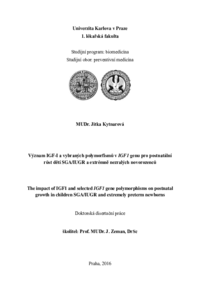Význam IGF-I a vybraných polymorfismů v IGF1 genu pro postnatální růst dětí SGA/IUGR a extrémně nezralých novorozenců.
The impact of IGF1 and selected IGF1 gene polymorphisms on postnatal growth in children SGA/IUGR and extremely preterm newborns.
dissertation thesis (DEFENDED)

View/
Permanent link
http://hdl.handle.net/20.500.11956/79312Identifiers
Study Information System: 85925
CU Caralogue: 990020871010106986
Collections
- Kvalifikační práce [4835]
Author
Advisor
Referee
Baxová, Alice
Houšťková, Hana
Faculty / Institute
First Faculty of Medicine
Discipline
-
Department
Department of Paediatrics and Inherited Metabolic Disorders First Faculty of Medicine
Date of defense
4. 5. 2016
Publisher
Univerzita Karlova, 1. lékařská fakultaLanguage
Czech
Grade
Pass
Keywords (Czech)
extrémně nízká porodní hmotnost, postnatální růst, polymorfismy v IGF1Keywords (English)
extremely low birth weight, postnatal growth, IGF1 gene polymorphismsSouhrn Prognóza dětí s extrémně nízkou porodní hmotností závisí na řadě endogenních a exogenních faktorů. Jejich studium včetně analýz polymorfismů genu IGF1 může prohloubit znalosti o poruchách postnatálního růstu a přispět k prevenci rozvoje kardiovaskulárních onemocnění a diabetu mellitus 2 u dětí s extrémně nízkou porodní hmotností v dospělosti. Cílem bylo prospektivní sledování antropometrických parametrů dětí narozených ve 22−25. a 26−27. týdnu gestace a studium vztahu mezi postnatálním růstem extrémně nezralých dětí, dětí malých vzhledem ke gestačnímu věku (SGA) a donošených dětí s přiměřenou porodní hmotností a délkou (AGA) a výskytem polymorfismů v IGF1: (CA)10-24 repetitivních polymorfismů v promotoru, (CT)n polymorfismů ve 2. intronu, mikrosatelitního markeru D12S318 v 3'UTR, (CA)n polymorfismu 216 bp v 2. intronu a 185 bp v 3'ÚTR. Materiál a metody. Soubor tvořilo 242 dětí narozených ve 22-27+6 týdnu gestace. Antropometrická data byla měřena ve 2 a 5 letech u 72 dětí narozených ve 22-25+6 týdnu (skupina I) and 85 dětí narozených ve 26-27+6 týdnu (skupina II). Polymorfismy IGF1 byly analyzovány u 51 extrémně nezralých dětí, 208 dětí s AGA a 59 dětí s SGA pomocí fragmentační analýzy. Antropometrické parametry byly měřeny u extrémně nezralých dětí a dětí s SGA ve věku 12 a 24 měsíců a u dětí s AGA...
Long-term outcome of extremely preterm neonates depends on many endogenous and exogenous factors. Long-term follow-up of extremely preterm neonates during childhood and analyses of IGF1 gene polymorphisms may help to better understand the problems connected with delayed postnatal growth and the progression of cardiovascular diseases and diabetes mellitus type 2 in adulthood. The aim was the long-term follow-up of anthropometric parameters in children born at 22−25th and 26−27th week of gestation and to study the association between postnatal growth of extremely preterm children, children small for gestational age (SGA) and children born at term with appropriate birth weight/length (AGA) and IGF1 gene polymorphisms: (CA)10-24 repetitive polymorphism in promoter, microsatellite marker D12S318 and 185 bp in 3'UTR, (CT)n polymorphism (CA)n polymorphism 216 bp in the intron 2. Methods. 242 infants born at 22-27+6 weeks were enrolled. Anthropometric parameters were measured at the ages of 2 and 5 years in 72 children born at 22-25+6 week (group I) and 85 children born at 26-27+6 week (group II). Polymorphisms of IGF1 were analysed in 51 extremely preterm, 208 AGA and 59 SGA children using fragment analyses. The data of postnatal growth data in AGA children were obtained at 18 months, in SGA and extremely...
